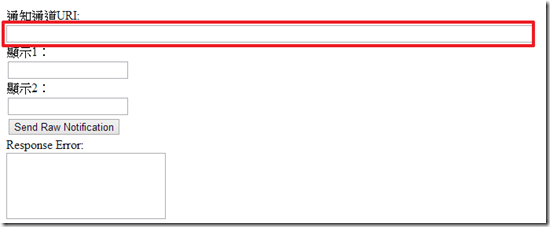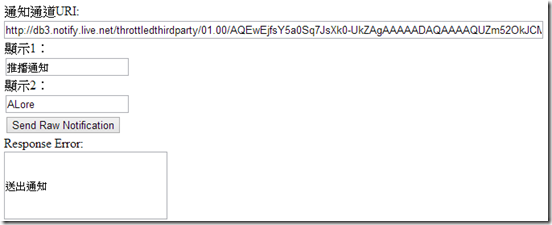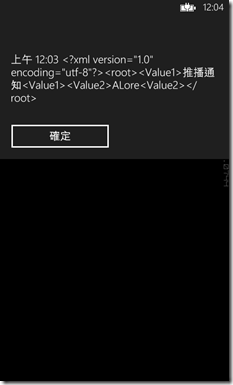【Windows Phone 8】結合ASP.NET進行推播
前言:
在開發手機應用程式中有時需要用到推播種功能,
於是在網路上找到這一篇有關如何進行推播的文章,
以下開始實作。
參考:【Notifications for Windows Phone】
實作:
在【方案總管】>【WMAppManifest.xml】>【功能】找到【ID_CAP_PUSH_NOTIFICATION】將它啟用
【Phone端】
Step-1 【MainPage】建構式中建立通知通道
//尋找有無此通知通道
HttpNotificationChannel push = HttpNotificationChannel.Find("RawSampleChannel");
if (push == null)
{
push = new HttpNotificationChannel("RawSampleChannel");
//回傳通知事件
push.ChannelUriUpdated += push_ChannelUriUpdated;
//回傳錯誤
push.ErrorOccurred += push_ErrorOccurred;
//回傳通知未處理
push.HttpNotificationReceived += push_HttpNotificationReceived;
//開啟通知通道
push.Open();
}
else
{
//回傳通知事件
push.ChannelUriUpdated += push_ChannelUriUpdated;
//回傳錯誤
push.ErrorOccurred += push_ErrorOccurred;
//回傳通知未處理
push.HttpNotificationReceived += push_HttpNotificationReceived;
//將通道的URI顯示在輸出與MessageBox中
System.Diagnostics.Debug.WriteLine(push.ChannelUri.ToString());
MessageBox.Show(String.Format("{0}", push.ChannelUri.ToString()));
}
{
Dispatcher.BeginInvoke(() => {
//將通道的URI顯示在輸出與MessageBox中
System.Diagnostics.Debug.WriteLine(e.ChannelUri.ToString());
MessageBox.Show(String.Format("{0}", e.ChannelUri.ToString()));
});
}
{
//回傳錯誤
Dispatcher.BeginInvoke(() => {
MessageBox.Show(String.Format("{0} {1} {2} {3}",e.ErrorType,e.Message,e.ErrorCode,e.ErrorAdditionalData));
});
}
{
string message;
//回傳通知未處理
using(System.IO.StreamReader sr=new System.IO.StreamReader(e.Notification.Body))
{
message = sr.ReadToEnd();
}
Dispatcher.BeginInvoke(() => {
MessageBox.Show(String.Format("{0} {1}", DateTime.Now.ToShortTimeString(), message));
});
}
<form id="form1" runat="server">
<div>
<br />
通知通道URI:</div>
<asp:TextBox ID="TextBoxUri" runat="server" Width="666px"></asp:TextBox>
<br />
顯示1:<br />
<asp:TextBox ID="TextBoxValue1" runat="server"></asp:TextBox>
<br />
顯示2:<br />
<asp:TextBox ID="TextBoxValue2" runat="server"></asp:TextBox>
<br />
<asp:Button ID="ButtonSendRaw" runat="server" onclick="ButtonSendRaw_Click" Text="Send Raw Notification" />
<br />
Response Error:<br />
<asp:TextBox ID="TextBoxResponse" runat="server" Height="78px" Width="199px"></asp:TextBox>
</form>
</body>
Step-2 發送推播事件(以Button觸發)
{
try
{
//將Phone的通知通道URI儲存在subscriptionUri變數中
string subscriptionUri = TextBoxUri.Text.ToString();
//建立Request(要求)
HttpWebRequest sendNotificationRequest = (HttpWebRequest)WebRequest.Create(subscriptionUri);
//Request(要求)方法以POST方式
sendNotificationRequest.Method = "POST";
//回傳message.
string rawMessage = "<?xml version=\"1.0\" encoding=\"utf-8\"?>" +
"<root>" +
"<Value1>" + TextBoxValue1.Text.ToString() + "<Value1>" +
"<Value2>" + TextBoxValue2.Text.ToString() + "<Value2>" +
"</root>";
//以UTF8編碼,位元組方式回傳
byte[] notificationMessage = Encoding.UTF8.GetBytes(rawMessage);
//將Request(要求)ContentLength標頭設為notificationMessage長度
sendNotificationRequest.ContentLength = notificationMessage.Length;
//設定Request(要求)ContentType為Xml
sendNotificationRequest.ContentType = "text/xml";
//將Request(要求)Headers名稱設為X-NotificationClass、值為3
sendNotificationRequest.Headers.Add("X-NotificationClass", "3");
using (Stream requestStream = sendNotificationRequest.GetRequestStream())
{
//將notificationMessage位元組複製到requestStream資料流中
//第二個參數為起始,第三個參數為結束
requestStream.Write(notificationMessage, 0, notificationMessage.Length);
}
//建立Response
HttpWebResponse response = (HttpWebResponse)sendNotificationRequest.GetResponse();
TextBoxResponse.Text = "送出通知";
}
catch (Exception ex)
{
TextBoxResponse.Text = "Exception caught sending update: " + ex.ToString();
}
}




